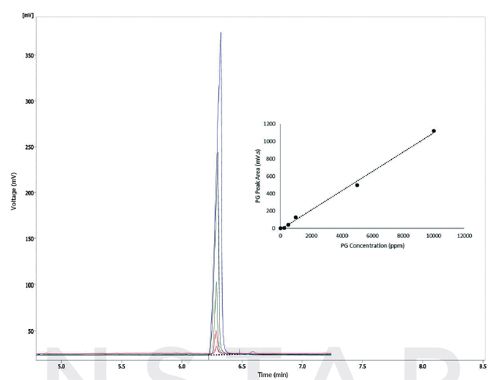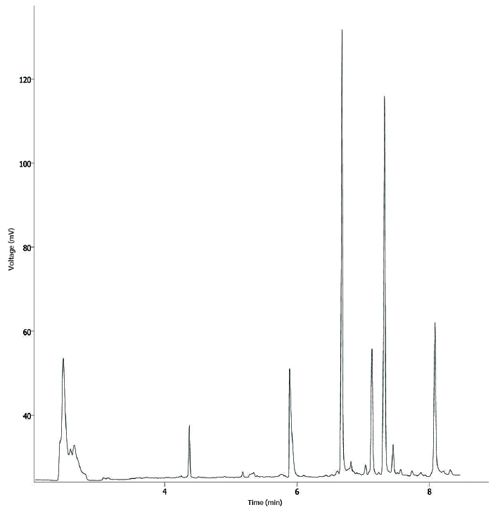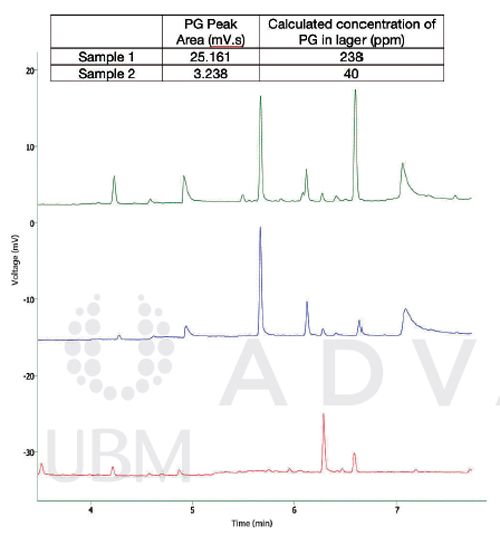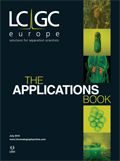Propylene Glycol (PG) in Alcoholic Beverages
The Application Notebook
Donna Kinder, Ellutia
Propylene glycol (PG) can be used as a food additive and is widely accepted as safe for human consumption at low levels. The WHO (World Health Organization) have set the maximum permissible daily intake of propylene glycol as a food additive at 25 mg/kg bodyweight. PG comes in several grades with food grade PG, often used in the external chilling systems of breweries, as well as ice cream production, amongst others. The brewing industry standard requires that PG used within the chilling system must be food grade at a concentration no less than 25% by volume. This mix of PG and water enables the brewer to achieving cooling temperatures between -2.7 °C and -3.3 °C (25–27 °F). Contamination of beer can occur as a result of a damaged vessel wall or pipework, resulting in PG from the coolant jacket entering the beer stream. In Europe, authorities are very cautious about acceptable uses of PG within the cosmetics and food industry and is limited to mostly nonâfood applications. Those that are permitted are very limited and it is not currently approved to add to beer. There is, however, an EU 1 g/kg limit in food (additive number E1520).
Analysis
An Ellutia 200 Series gas chromatograph with a flame ionization detector (FID) was used for the analysis. The only sample preparation required was for the sample of beer degassed. This can be achieved by sonicating the sample or by repeatedly pouring the sample between two beakers. Once degassed the sample can be directly injected into the GC.
Figure 1: A chromatogram of a 0.5 µL injection of 700 ppm solutionof propylene glycol in a generic lager, with a retention time of approximately 6.7 min. This chromatogram shows good peak shapes and indicates little interference from the matrix components.

Figure 2: Calibration set 250–10,000 ppm propylene glycol in 5% ethanol solution, R2 = 0.996. Good lineaity and correlation is observed.

GC Conditions
Injector temperature (°C): 230
Carrier gas type: Hydrogen
Split flow (mL/min): 30
Column flow (mL/min): 3.0 simulated constant flow
Injection volume (µL): 0.5
Column type: 15 m × 0.25 mm, 0.25-µm df EL-WAX
Column Temperature Program:
Initial temperature (°C)/hold time (min): 50/0
Temperature ramp (°C/min): 10
Final column temperature (°C)/hold time (min): 200/0
Detector: FID
Detector temperature (°C): 240
Figure 3: Comparison of two shop purchased lagers with a 250 ppm PG in 5% ethanol solution. Sample 1 - Green, Sample 2 - Blue, and 250 ppm PG in 5% ethanol solution - Red. From the peak areas of each sample, the concentration of PG has been calculated and is shown in the inserted table.

Conclusion
Analysis of propylene glycol content in lager can be achieved using an Ellutia 200 Series gas chromatograph with an FID. Initial testing has indicated that there are low PG concentrations in commercially available lagers. Sources of PG found in these samples cannot be established off-site and any unintentional contamination of these samples would need to be investigated. Intentional PG content should be monitored and levels should be kept within permissible levels. As daily exposure levels are subjective to an individual’s bodyweight and average consumption of lager, and other potential food sources of PG, it would seem prudent to reduce the levels of PG that an individual could be exposed to.

Ellutia Ltd
12–16 Sedgeway Business Park, Witchford, Cambs, CB62HY, UK
Tel: +44 (0)1353 669916 Fax: +44 (0)1353 669917
E-mail: info@ellutia.com Website: www.ellutia.com

Analytical Challenges in Measuring Migration from Food Contact Materials
November 2nd 2015Food contact materials contain low molecular weight additives and processing aids which can migrate into foods leading to trace levels of contamination. Food safety is ensured through regulations, comprising compositional controls and migration limits, which present a significant analytical challenge to the food industry to ensure compliance and demonstrate due diligence. Of the various analytical approaches, LC-MS/MS has proved to be an essential tool in monitoring migration of target compounds into foods, and more sophisticated approaches such as LC-high resolution MS (Orbitrap) are being increasingly used for untargeted analysis to monitor non-intentionally added substances. This podcast will provide an overview to this area, illustrated with various applications showing current approaches being employed.

.png&w=3840&q=75)

.png&w=3840&q=75)



.png&w=3840&q=75)



.png&w=3840&q=75)









